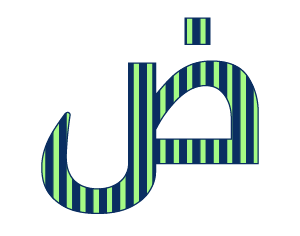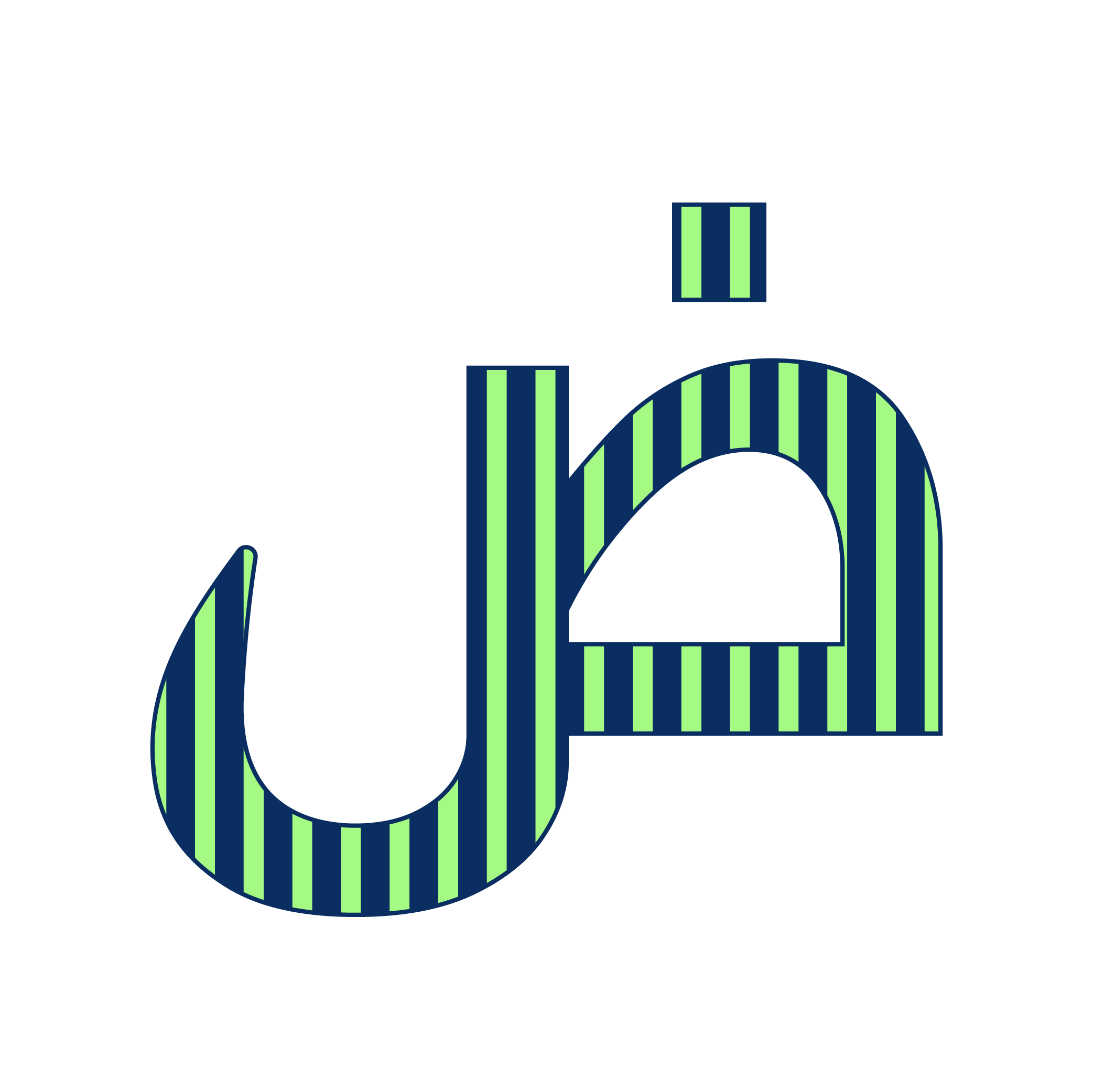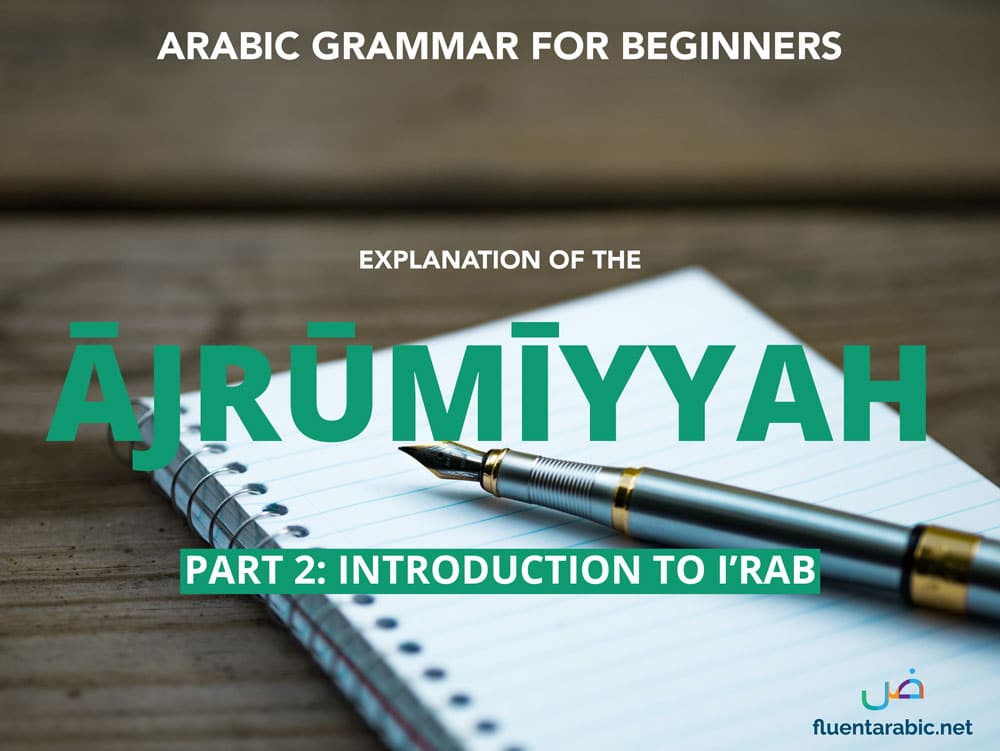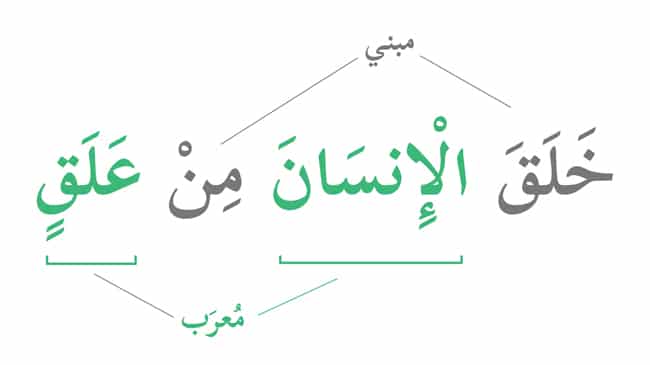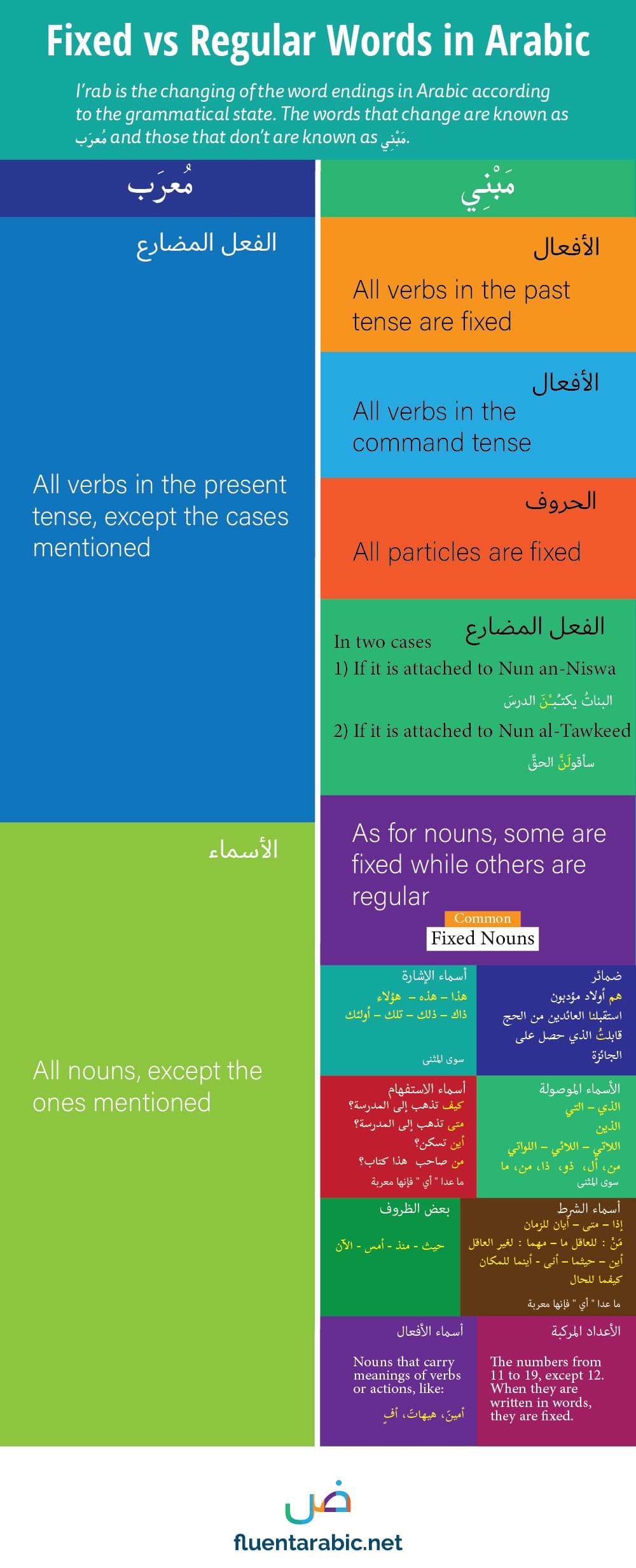Part 2: I’rab
Matn: Text of Al-Ajrumiyyah
الإِعْرَابُ : هُوَ تَغْيِيْرُ أَوَاخَرِ الكَلِمِ، لِاخْتِلَافِ العَوَامِلِ الدَّاخِلَةِ عَلَيْهَا لَفْظًا أَوْ تَقْدِيْرًا، وَأَقْسَامُهُ أَرْبَعَةٌ: رَفْعٌ، وَنَصْبٌ، وَخَفْضٌ، وَجَزْمٌ.
Translation: The I’rab: is the changing of the word endings due to the addition of specific elements whether they are actual or supposed. It has four states: Raf’, Naṣb, H̱afdh and Jazm.
What is I’rab? The I’rab is defined as the change of the vowel marking on the final letter of the word. This is caused by particles or words that are added or linked to the word. These words and particles can be written, or supposed.
Mabni and Mu’rab
Before we proceed, we are going to understand another important classification. In Arabic, not all words change their endings due to I’rab, some words are fixed. These words are known as مَبْنِىٌ. The words that do change their endings are known as مُعْرَبٌ.
This is another important classification that can help you determine the I’rab of words. Let’s look at a simple ayah from the Quran
The words shown as Mabni are always fixed. In other words, their vowels don’t change because of I’rab. So you don’t need to worry about them when you try to determine the I’rab of a sentence. So it is important to know which words are Mabni in Arabic and which ones are Mu’rab.
Verbs in the past tense and command tense are all Mabni. All particles are Mabni. So we just need to worry about nouns and verbs in the present tense.
Let us go through present tense verbs first:
All present tense verbs like: (يقُومُ، يضْرِبُ، يفْعَلُ، يسمَعُ) are Mu’rab except in two cases:
- If it is attached to Nun an-Niswa at the end. For example: البناتُ يكتُبْنَ الدرسَ. Here the Nun of Feminine Plural when attached to the verb ‘write’ to mean ‘They are writing (multiple females)’, causes the last letter of the verb to have sukun. This is the case no matter what the I’rab of the verb is.
- If it is attached to Nun at-Tawkeed. For example: لَأقولَنَّ الحَقَّ. This sentence means, I shall definitely speak the truth. The Nun at the end of the verb is for emphasis or confirmation. When this Nun is attached to the verb, the last letter of the verb always takes fatha.
As for nouns, most of them are Mu’rab except for a few categories. Some linguists count 10 categories in total, but we will just mention 8 common ones here insha’Allah.
- الضمائر or Pronouns: These are two types:
i. Independent:هو، هما، هم، هي، هُنّ، أنت، أنتِ، أنتما، أنتم، أنتنّ، أنا، نحن
ii. Attached: These are the ones that are attached to the end of verbs and nouns like: ت، نا، ي، ك as in,
ذهبتُ إلى البيت،
رجعنا من المسجد،
فقدت حقيبتي في القطار،
رجع صديقُكَ من سفرهِand so on. All these pronouns are fixed and do not change with I’rab.
- أسماء الإشارة or demonstrative pronouns: هذا، هذه، هؤلاء، ذلك، تلك، أولئك.
Did you notice we did not mention the dual forms? That is because the dual forms of demonstrative pronouns are Mu’rab. - الأسماء الموصولة or relative pronouns: الذي، الذين، التي، اللائي، اللاتي، اللواتي and also some that become related pronouns when used in such a context like: من، أل، ذو، ذا، من، ما
Again, the dual forms are an exception to this rule. - أسماء الاستفهام or interrogative nouns: مَن، مَا، متى، أيّان، أينَ، كيف، أنَّى، كم, except أيّ because it is Mu’rab.
- أسماء الشرط or conditional pronouns: ذا، متى، ما، مهما، أين، حيثما، أنى، أينما، كيفما, except أيّ because it is Mu’rab.
- بعض الظروف or some adverbs: حيث، منذ، أمس، الآن
- الأعداد المركبة or compound number: from 11 to 19, except for 12 as it is Mu’rab.
- أسماء الأفعال or verb nouns: These are special nouns which carry the meaning of verbs or actions like أمين which is a noun but means ‘answer the dua’ (action). Or أفٍ which is used to express displeasure.
To download a higher resolution PDF of the infographic above click here.
Matn: Text of Al-Ajrumiyyah
فَلِلْأَسْمَاَءِ مَنْ ذَلِكَ الرَّفْعُ، وَالنَّصْبُ، وَالْخَفْضُ، وَلَا جَزْمَ فِيْهَا. وَلِلْأَفْعَالِ مِنْ ذَلِكَ : الرَّفْعُ ، وَالنَّصْبُ، وَالْجَزْمُ وَلَا خَفْضَ فِيْهَا.
Translation: Of these, the nouns take (the states of) Raf’, Naṣb and H̱afdh; and not Jazm. The verbs take Raf’, Naṣb and Jazm; and not H̱afdh.
Now that we have identified the nouns and verbs which are Mu’rab, we can narrow down their i’rab even further. The nouns only take the Raf’ (رفع), Naṣb (نصب) or H̱afdh (خفض) forms and don’t accept Jazm (جزم). As for verbs, they accept Raf’ (رفع),Naṣb (نصب), and Jazm (جزم) and not H̱afdh (خفض).
What does this mean? Let’s take a noun: بَيْتٌ
It can take 3 grammatical states:
البيتُ قريبٌ (رفع)
دَخَلَ الوَلَدُ البيتَ (نصب)
ذَهَبَ الوَلَدُ إلى البيتِ (خفض)
It cannot be بيتْ under any circumstance.
Now let’s look at verbs. As we know only verbs in the present tense take I’rab. Present tense verbs can have 3 grammatical states as well:
الطالبُ يَقْرأُ الكتابَ (رفع)
يُحِبُّ الطالبُ أنْ يَقْرَأَ الكُتُبَ (نصب)
لمْ يَقْرَأْ الطالبُ الدّرْسَ (جزم)
And it can never be H̱afdh.
Next Lesson:
Part 3: Knowing the Signs of I’rab
Previous Lesson:
